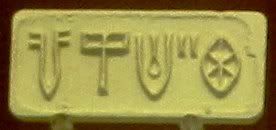 |
This picture shows a Harappan seal with five inscriptions or characters, which have been undeciphered. In fact there are many decipherments, but no scholarly consensus. One of the disputes is at a fundamental level: do these markings belong to a language or were the Harappans illiterate?
Finally, in a breaking news moment, we have an answer.
Now, a team of Indian scientists reports in Friday’s issue of Science journal that the Indus script has a structured sign system showing features of a formal language. Using mathematical and computational tools, researchers show that the script has well-defined signs, which begin and end texts, with strong correlations in the order in which the signs appear.[Scientists inch closer to cracking Indus Valley script – Home – livemint.com]
According to Asko Parpola, an expert on Indus seals
“It’s a useful paper,” said University of Helsinki archaeologist Asko Parpola, an authority on Indus scripts, “but it doesn’t really further our understanding of the script.”
Parpola said the primary obstacle confronting decipherers of fragmentary Indus scripts — the difficulty of testing their hypotheses — remains unchanged. [Artificial Intelligence Cracks 4,000-Year-Old Mystery | Wired Science from Wired.com]
Also
J. Mark Kenoyer, a linguist at the University of Wisconsin-Madison, says Rao’s paper is worth publishing, but time will tell if the technique sheds light on the nature of Indus script.
“At present they are lumping more than 700 years of writing into one data set,” he says. “I am actually going to be working with them on the revised analysis, and we will see how similar or different it is from the current results.”[Scholars at odds over mysterious Indus script – life – 23 April 2009 – New Scientist]
Additional Reading:
Of all the exponents of Indus seals Mr.MICEL DAIMINO’S remarks only seems to be logical. He has completely demolished Dravidian and Aryan origin of Indus seals. DR. IRAVATHAM MAHADEVAN’S explanation of spear like symbol and jar as MURUKAN ably supported by ASKO PARAPOLA will bring laughter when one is familiar with TAMIL BRAHMINICAL ORNAMENTS. Till one hundred years ago the women of one sect of Tamil Brahmins viz., VADAMA were identified by gold chain worn by them as DOUBLE VADAMS. The meaning of vadam in Tamil is twisted i.e.,”MURUKKU”. The important point omitted by Iravatham Mahadevan and Asko Parpola is while “r” in Murukan is unaspirated “r” while Murukku, Muri is aspirated “r” which is special in Tamil. Further Murru and Muru has opposite meaning viz., Muruhal is liked by all Tamilians which is pale reddish with ilansivappu while Murruku means tough, unbendable etc., Normally among Tamil Brahmins the sub sect VADAMAS were once known for tough uncompromising even among their blood relations. Thus with Murruku instead of Muruku and Vadam identified with wheat granule/spear it is translated as VADAMAN which is relatively a term used to denote expert/government official/elder person etc.,in Sangam literature. The whole theory is not to analyze the seals but to justify the concept of MURUHA as PURE TAMILIAN with tribal affinity a favorite concept of Dravidian mythology contrasting with VAISHNAVISM as Aryan. VELAN VERIYADAL alone is not tribal. DEVARATTAM popularly known as THEYAM in Kerala is also one among veriyadal. The NARASIMHA AVATHARA AND VARAHA AVATHARA are also tribal. The whole misconception about DIVINE POSSESSION is due to non recognition of SAKTHA FORMS which is as old as dawn of civilization but not recognized by vedantins. Though the close similarities between Elamite and Indus seals have been brought forth the possible translation/transliteration may yield some results. The culture of North India is peculiar in the sense that the commonfolk are unaffected by invasion since they don’t have interest in writing/painting or oral folklore. Hence they have a continuous culture. However the elite of North India and the whole of South India change the lifestyle/record events etc., with regard to invasions and thus the culture of elite North/South is discontinuous. Thus just as so many capitals like Ujjain/Badami/Kanauj etc., have become totally irrelevant now the Indus Civilization had become redundant with the collapse of pre historic culture of Middle East. Thus Indus seals will be Indus seals only neither Dravidian nor Aryan but vanished with time. Linking it with Aryan or Dravidian is self satisfaction and satisfaction of Political class only.